Short TL;DR
Scybernethics is an innovative approach to understanding natural and artificial intelligence. By combining historical and theoretical knowledge production with reflexive computer simulations, Scybernethics offers a unique perspective that can help us navigate the complex and rapidly evolving world of technology and at the same time trying to better understand ourselves. Through its heuristical cycles and phenomenological first-person point of view, Scybernethics helps us better understand the nature of machines and their potential for enhancing our collective social intelligence. By embracing Scybernethics, we can catalyze a better understanding of Nature, AI and ourselves, induce an enlivenment in living beings, and develop a more holistic and sustainable approach to the use of technology. Join us in this initiative to shape the future² of our relationship with machines and foster a more intelligent and resilient society.
“Scybernethics: shaping the future² with natural intelligence and enhancing our personal and collective cognition toward “Knowing societies” and enlivening the planet.“
A little longer TL;DR in 12 parts
Title: Exploring the relationship between cognition and life through interbeing and enaction
Part 1: The author starts by reflecting on the relationship between cognition and life. They argue that life is not just a physical process, but also involves cognition.
Part 2: The author talks about interbeing, which means that everything is interconnected and interdependent. They argue that interbeing can be a useful concept for understanding the relationship between cognition and life.
Part 3: The author discusses the work of Francisco Varela, a scientist who studied cognition and the mind-body problem. Varela’s ideas are relevant for understanding the relationship between cognition and life.
Part 4: The author explores the idea of “enaction,” which is the idea that cognition and the environment are co-constitutive. They argue that enaction can help us understand the relationship between cognition and life.
Part 5: The author talks about the importance of embodiment for understanding cognition and life. They argue that the body plays a key role in shaping our experiences and understanding of the world.
Part 6: The author reflects on the need for a new way of thinking about the relationship between cognition and life. They argue that we need to move beyond traditional dualistic thinking and embrace a more holistic approach.
Part 7: The author discusses the work of Gilbert Simondon, a philosopher who explored the relationship between technology and humanity. Simondon’s ideas are relevant for understanding the relationship between cognition and life.
Part 8: The author talks about the importance of language and communication for understanding cognition and life. They argue that language plays a key role in shaping our experiences and understanding of the world.
Part 9: The author explores the idea of “meaning-making,” which is the idea that we actively construct meaning in the world. They argue that meaning-making is an important aspect of cognition and life.
Part 10: The author reflects on the role of ethics in understanding cognition and life. They argue that ethics should be at the forefront of our thinking about the relationship between cognition and life.
Part 11: The author talks about the need for a new approach to understanding the relationship between cognition and life. They argue that we need to embrace a more creative and hermeneutical approach.
Part 12: The author concludes by reflecting on the relationship between cognition and life, and the importance of interbeing and enaction for understanding this relationship. They argue that we need to move beyond traditional dualistic thinking and embrace a more holistic approach.
*** [ChatGPT3 generated, not very accurate]
Accessing the Scybernethic(s) summary or directly the core article (50 pages), both with a clickable table of content.
°°°°~x§x-<@>



